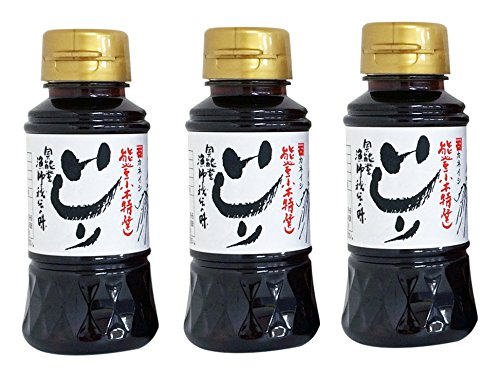Ishiru: The Traditional Japanese Fish Sauce

“Ishiru” is a unique fermented seasoning, a fish sauce, specific to Ishikawa Prefecture located in
the northwestern part of Honshu, Japan.
Ishiri, not to be mistaken for Ishiru, is a type of fish sauce made from the intestines of Ma-ika, a kind of Japanese squid. It is considered one of the top Three Great Fish Sauces in Japan together with Shottsuru from Akita and Ikanago Shoyu from Kagawa. Among the three, Noto’s Ishiri boasts of the largest production volume in all of Japan.
In recent years, it has also gained attention and appreciation outside of Japan after it made an appearance at the World Cuisine Summit in Tokyo in February of 2009.

Check out our new cookbook
Bitemybun's family recipes with complete meal planner and recipe guide.
Try it out for free with Kindle Unlimited:
Read for freeIn this post we'll cover:
In what region is Ishiru produced?
The Hokuriku region is well known for its harsh winter cold and snowy climate. Due to the tradition
of storing up during the summer and engaging in indoor work during the winter, people in this
region are often recognized for their sincerity, patience, and thoughtful nature.
Moreover, the region benefits from abundant nutrients in the meltwater and rainwater from the
snow-covered mountains, including Mount Hakusan, one of Japan’s three sacred peaks. This
nutrient-rich runoff flows from rivers to the sea. Consequently, the environment is conducive to
the proliferation of small fish as feed, creating an ideal habitat for fish to grow deliciously.
What are the characteristics of Ishiru?
Ishiru is primarily made by salting whole sardines and allowing them to ferment for approximately
one to two years. The liquid extracted after fermentation becomes Ishiru.
Ishiru allows one to enjoy the richness without the pronounced fishy smell or taste. In Japan, it is
considered one of the “Three Great Fish Sauces,” alongside Shottsuru from Akita Prefecture and
Ikanago Shoyu from Kagawa Prefecture. Used widely as a seasoning over 300 years ago, before
the production of soy sauce, Ishiru faced a decline in production.
The earthquake in January 2024 dealt a blow to its production areas, and despite the usual
February production season, unfortunately, this year’s production had to be abandoned due to
these challenges. But the people known for their diligence, will surely revive Ishiru.
How does ishiru differ from other Japanese and other fish sauces?
A significant difference from Nampla lies in its flavor. In contrast to the warmer climates of Thailand and Vietnam, Ishiru undergoes long-term low-temperature fermentation in colder regions. This process helps to suppress the fishy smell, resulting in a subtle fragrance, delicacy of taste, and a clear, low impurity
profile.
While Nampla excels in more intense cooking, Ishiru is known for facilitating delicate
seasoning. If someone is sensitive to the fishy odor of Nampla, trying Ishiru first might be a good
idea.
The other fish sauces of Japan are made in different conditions and cultural heritage, making ishiru unique in its subtlety.
Is it Ishiru or Ishiri?
The fish sauce from Ishikawa Prefecture has 2 variations:
- On the east coast of the region, people used to make it from squid liver.
- On the Noto Peninsula, they make it from sardines.
Although the names “ishiru” and “ishiri” are sometimes used interchangeably, some sources state that ishiru fish sauce refers to the one made from squid innards. Meanwhile, ishiri fish sauce is the sardines one.
The similar name aside, both sauces actually originate and are produced in the Noto-region. Ishiri is mainly produced in Uchi-ura, whereas Ishiru originated in the Soto-ura area.
Ishiru is generally made using either mackerel or sardines as the main ingredient along with 20% salt. The entire process from start to finish usually takes up to a year.
Ishiri on the other hand is made from the intestines of squid that is then left to ferment along with 18% salt for between 2-3 years before being boiled, having impurities removed and finally being ready for consumption. The reason for using less salt in making Ishiri is because of the squid’s high fat content compared to sardines.
Both of these sauces have been made for a very long time, however, just how long is unknown. There are no known records for when or why the making of these sauces actually started. That said, local Ishiri makers claim that the methods for making Ishiri was already known and established around the latter half of the 18th century, or around the middle of the Edo period in Japan.
Some manufacturers today still use wooden barrels for production that are believed to be from that period.
Only a couple of generations ago, you could find a wooden barrel used for making Ishiri in nearly every household in the region, however, these days the production of the sauces is centered around only a few main manufacturers.
Despite this, business is booming. Research shows that while only 33 tons were manufactured in 1987, one single company alone today will produce upwards of 180 ton Ishiri annually.
Just like it’s unclear when production of the sauce started, so is the origins of the name itself. There are however plenty of theories floating around about where the name might have come from. Perhaps one of the most popular theories is that the ancient word for “fish” in Japanese is “io” or simply “i”. “Shiru” on the other hand means “soup” or “juice” in Japanese, so it’s fairly easy to make the assumption that the name Ishiri or Ishiru is simply a corrupted form of “Io-shiru”, aka “fish sauce”.
But that is not all! Ishiri is also known by the monikers “Yoshiru” or “Yoshiri” which can be translated as “soup with extra fish”. A fish sauce made with extra salt (“shio” in Japanese) on the other hand would then be refered to as “Shio-shiru” or “Shio-shiri”.
The most popular dish in this region is the ishiri kaiyaki, a squid dish grilled with fish sauce.
People also love using ishiri in many other dishes, such as sashimi and asazuke pickles. Adding ishiri to those dishes may enhance the richness of the flavor without making it taste too much like sauce.
My favorite for this very reason is this Jinshi ishiri fish sauce that’s not too overpowering:

What do you make with ishiru?
Traditionally, Ishiru has been used to make broth for simmered dishes and hot pot recipes. When
making Ishiru hot pot with Ishiru broth, you can use a ratio of 1 part Ishiru to 6 parts water to
create the stock. Since Ishiru has a higher salt content compared to soy sauce, consider using
about 60% of the usual amount when seasoning to avoid over-salting.
Heating Ishiru reduces its fragrance while enhancing its umami, making it a popular choice for
adding depth to dishes like ramen and imparting aroma to fried rice (chahan). Start by adding just
a drop to your ramen and experiment with the flavor. You can also try dipping a small amount on
sashimi to explore its taste.
Ishiru complements Mediterranean dishes such as Aqua Pazza, Paella, Spaghetti aglio e olio, and
Bouillabaisse.
Consider keeping Ishiru nearby and experimenting with various recipes. These experiments are
sure to have positive effects on your health and life.
The sauce is meant to be used as a kind of hidden flavor enhancer in food and has a very discrete flavor that brings out the umami in most foods it’s paired with.
Traditionally it is known to go very well with sashimi, Asazuke (lightly pickled vegetables), boiled foods and Nabe-dishes (Japanese hotpot).
Ishiri Kaiyaki is perhaps one of the most well-known and famous Ishiri-dishes out of Noto-cho. The dish is simply prepared by putting Ishiri sauce in a large scallop shell and broiling it together with other ingredients such as squid, small pieces of eggplant, enoki mushrooms and green onions. Once the dish starts simmering, it’s ready to be eaten!
Another popular way to use the sauce is by diluting it slightly with water and using it to pickle cucumbers or Japanese radishes, otherwise known as “Ishiri Zuke”.
Japanese dishes aside, the sauce can also be used in other types of cuisines, such as Chinese or even western dishes to bring out an unique flavor in the dish.
Ben Flatt is an Australian chef who settled down in Noto after being attracted to the local cuisine and Ishiri. He ended up marrying the daughter of the owner of a famous local guesthouse and restaurant in Sannami and has since then established his own guesthouse and establishment in town.
Ben’s speciality is Italian food and he has attracted plenty of foodies not only in Japan but from overseas who travel to Noto specifically for the chance to taste “Noto Italian” which features Ben’s own homemade Ishiri.
Ben actually presented one of the more popular Ishiri dishes at the World Cuisine Summit in 2009; a special potato soup with Ishiri that proved a hit with everyone who tried it.
How is ishiru different from other Japanese fish sauces?
Ishiru differs from other Japanese fish sauce types because it uses squid liver. It’s the only fish sauce that uses this as the main ingredient.
The delicious umami flavor aside, through extensive research it has been revealed that Ishiri sauce actually contain higher levels of amino acids compared to other fish sauces, both local and international. It also contains antioxidants, low molecular peptides and other healthy agents that help suppress blood pressure elevation.
Check out our new cookbook
Bitemybun's family recipes with complete meal planner and recipe guide.
Try it out for free with Kindle Unlimited:
Read for freeNicole trained to become a baker and pastry chef in Sweden, then packed her bags to spend the next decade traveling around Southeast Asia before finally settling down with her family in Japan.
